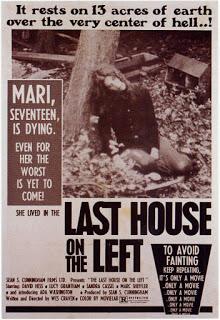
Directed By: Wes Craven
Starring: Sandra Peabody, Lucy Grantham, David Hess
Tag line: "Mari, 17, is dying. Even for her the worst is yet to come"
Trivia: This movie was banned for over 32 years in Australia. It was finally commercially available through DVD in 2004
Back in 2006, when I was working as a buyer for a meat-packing plant, a co-worker of mine, a middle-aged woman named Bea, asked me what I thought was the scariest movie I’d ever seen. “The Exorcist” was my immediate reply (though I also told her about my love for The Texas Chain Saw Massacre and John Carpenter’s The Thing). Naturally, I posed the same question to her, and while she didn’t remember the film’s name, I knew from her description of it (2 teens are kidnapped by rapists / killers and dragged into the woods) that it was Wes Craven’s directorial debut, 1972’s The Last House on the Left (which borrowed heavily from Ingmar Bergman’s 1960 classic The Virgin Spring). Bea was a teenager, around the same age as the film’s doomed young lead, when she and a few of her friends saw this in the theater, and the experience was almost too much for her. A brutal, unflinching motion picture, The Last House on the Left undoubtedly had this same effect on thousands of girls the world over.
Mari Collingwood (Sandra Cassel) is about to turn 17. As her parents, John (Richard Towers) and Estelle (Cynthia Carr), prepare for her upcoming party, Mari and her slightly wild friend Phyllis (Lucy Grantham) head to New York to attend a concert. Once in the city, Phyllis tries to score them some grass, and approaches Junior (Marc Sheffler) on the street, asking if he knows where they can get some. Promising to hook them up, Junior leads Phyllis and Mari back to his apartment, where, instead of marijuana, they find three escaped criminals: Krug (David Hess), Sadie (Jeramie Rain), and Weasel (Fred Lincoln), who immediately take the naïve young girls as their prisoners.
The next morning, Krug and the others throw their two hostages into the trunk of a car and head out into the country, where, quite ironically, they break down on the very road that Mari and her parents live on. Once the gang has “finished” with Phyllis and Mari, they head to the nearest house, which happens to belong to the Collingwoods! Despite being worried that their daughter hasn’t returned home yet, John and Estelle invite the group to stay in their home. But it isn’t long before the distraught parents discover the truth, leading to a showdown that’s sure to end in more bloodshed.
“Certainly the deepest horror”, Wes Craven once said, “is what happens to your body at your own hands and others”. And what happens to Mari and Phyllis in The Last House on the Left at the hands of Krug and his cronies is about as horrific as it gets. Once the actions shifts to the woods near Mari’s house, the two girls are humiliated beyond belief (aside from being forced to have sex with one another, Phyllis is made to urinate in her own pants) before being tortured, and much worse. What makes it even more chilling is that Craven allows his camera to linger, focusing quite intently on these disturbing events (he doesn’t show us everything, thankfully, but we definitely see enough). I’d watched the movie once or twice before, yet a foreknowledge of what's to come doesn’t help much. In fact, the film’s middle sequence always has the same effect on me: by the time the evil Krug (Hess is absolutely terrifying in the role) and his cohorts have finished with Mari and Phyllis, I’m shocked, disgusted, and mentally drained.
I do have some issues with The Last House on the Left, primarily the characters of the bumbling sheriff (Marshall Anker) and his deputy (Martin Kove), whose scenes would be more at home in a Laurel and Hardy comedy short (while on their way to investigate the abandoned car in front of the Collingwoods, their own vehicle breaks down, forcing them to hitch a ride with a passing chicken farmer). I realize Craven was trying to lighten the mood with some comedy, but to throw these antics in after what is easily the film’s most alarming scene was a mistake (I’m fairly certain nobody was in a laughing mood at that moment). That said, this movie has definitely left its mark on the genre, and as tough as it is to sit through, horror fans should make a point of doing so at least once.
